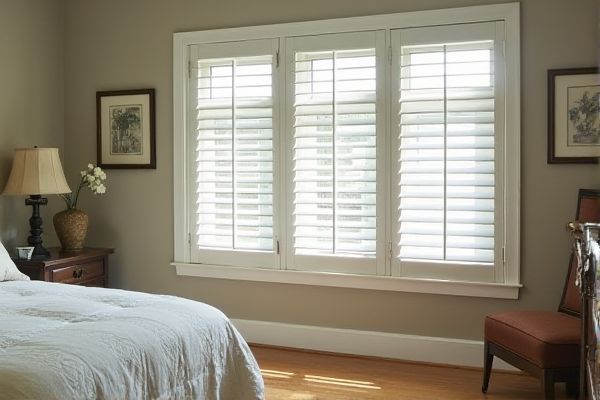
Louvered shutters feature horizontal slats that allow airflow and light control, offering a classic, functional look, while board and batten shutters consist of vertical boards secured with horizontal battens, providing a rustic, sturdy aesthetic. Explore the rest of the article to discover which shutter style best suits your home's design and practical needs.
Table of Comparison
| Feature | Louvered Shutter | Board and Batten Shutter |
|---|---|---|
| Design | Horizontal slats angled for ventilation and light control | Vertical boards secured by horizontal or diagonal battens |
| Material | Commonly wood, vinyl, or composite | Typically wood; sometimes vinyl or composite |
| Functionality | Allows airflow and partial light while providing privacy | Primarily decorative; offers full coverage and privacy |
| Style | Traditional, colonial, coastal aesthetics | Rustic, farmhouse, classic exterior look |
| Maintenance | Moderate; requires cleaning between slats | Lower; simpler flat surfaces to clean |
| Installation | Requires precise alignment of louvers | Basic installation with boards and battens |
| Cost | Generally higher due to design complexity | Typically lower and more budget-friendly |
Introduction to Louvered and Board and Batten Shutters
Louvered shutters feature horizontal slats angled to allow ventilation and light while providing privacy and shade, ideal for enhancing your home's airflow and aesthetic appeal. Board and batten shutters consist of vertical boards secured by horizontal battens, offering a rustic, sturdy look that emphasizes traditional charm and durability. Choosing between these shutters depends on your preference for ventilation and style, with louvered shutters suitable for a classic, airy feel and board and batten shutters delivering a bold, farmhouse-inspired design.
Design Differences: Louvered vs Board and Batten
Louvered shutters feature horizontal slats that allow for ventilation and light control, creating a classic, functional appearance ideal for traditional or coastal-style homes. Board and batten shutters consist of vertical wide boards secured with narrower battens, offering a rustic, sturdy look that enhances farmhouse or cottage aesthetics. Your choice between these shutters impacts both visual appeal and practical benefits such as airflow and privacy.
Material Options for Each Shutter Style
Louvered shutters are commonly crafted from wood, vinyl, or composite materials, providing excellent ventilation and a classic appearance for your home. Board and batten shutters typically use wood or fiber cement, known for their durability and rustic charm, making them ideal for a variety of architectural styles. Understanding the material options helps you choose the right shutter style that balances aesthetic appeal with maintenance needs.
Aesthetic Appeal and Home Architecture Compatibility
Louvered shutters offer a classic, airy aesthetic ideal for traditional, coastal, or colonial-style homes, enhancing ventilation and light control while adding timeless charm. Board and batten shutters deliver a rustic, sturdy look perfect for farmhouse, cottage, or craftsman architecture, creating bold visual interest with their solid panels and vertical battens. Choosing between them depends on your home's architectural style and desired exterior ambiance to maximize curb appeal and coherence.
Energy Efficiency and Ventilation Comparison
Louvered shutters provide superior ventilation by allowing air to flow through angled slats, helping regulate indoor temperature and improve energy efficiency. Board and batten shutters, made from solid panels, offer enhanced insulation by blocking drafts and reducing heat transfer, which can lead to better energy conservation in colder climates. Choosing the right shutter for your home depends on whether you prioritize airflow and cooling or insulation and heat retention.
Durability and Maintenance Requirements
Louvered shutters offer excellent ventilation and resistance to weather damage due to their angled slats, making them durable and easier to maintain with regular cleaning and occasional repainting. Board and batten shutters, composed of solid vertical panels joined by battens, provide robust protection against harsh elements but may require more frequent inspections for warping or cracking, especially in humid climates. Your choice should consider the environmental exposure and how much time you can dedicate to upkeep to ensure long-lasting performance.
Installation Process: Louvered vs Board and Batten Shutters
Louvered shutters feature horizontal slats that require precise alignment and secure fastening, making their installation slightly more intricate compared to board and batten shutters, which consist of flat panels and vertical battens that are easier to mount with basic tools. The installation process for louvered shutters often demands careful measurement to ensure even spacing of louvers for proper ventilation and aesthetic appeal. Board and batten shutters provide a simpler, more straightforward installation due to their solid construction and fewer components, reducing the potential for misalignment during mounting.
Cost Comparison and Budget Considerations
Louvered shutters typically cost more than board and batten shutters due to their intricate design and material requirements, with prices ranging from $100 to $250 per pair compared to $50 to $150 for board and batten options. Your budget should account for installation expenses, as louvered shutters often require professional fitting to ensure proper alignment of slats, while board and batten shutters can be easier and cheaper to install. Choosing between these styles involves balancing aesthetic preferences against upfront costs and long-term maintenance expenses.
Customization and Color Choices
Louvered shutters offer extensive customization options with adjustable slats that control light and airflow, available in a wide range of colors and finishes to complement diverse architectural styles. Board and batten shutters provide a more rustic, classic look, featuring solid panels with vertical battens, customizable through paint or stain colors to match your home's exterior. Your choice between these shutters will depend on the desired aesthetic and functional flexibility for your property's design.
Which Shutter Style Is Right for Your Home?
Louvered shutters offer adjustable slats that provide ventilation and light control, making them ideal for homes in warmer climates or with a need for airflow while maintaining privacy. Board and batten shutters feature a rustic, solid panel design that enhances curb appeal through a traditional or farmhouse aesthetic, perfect for homes seeking a bold, architectural statement. Choosing between these styles depends on your home's architectural design, climate considerations, and desired balance between functionality and visual impact.
 homyna.com
homyna.com